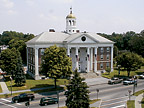
However, no one wanted to preserve the existing heating and cooling system, which featured a wheezy steam boiler and gusty window and ceiling fans. City manager John Salomone was surprised to learn there was no air conditioning in the building when he arrived a few years ago. Summer temperatures occasionally topped 95°F in some offices.
City Hall's new heating and cooling system had to meet several criteria. It had to be cost-effective, energy efficient, provide a more comfortable working environment, and blend into the landmark building both inside and out. While a gas boiler and central air system was a conventional choice, John Manning, P.E., who heads his own design firm, Earth Sensitive Solutions, LLC, recommended an alternative.
The Geoexchange Alternative
The results of a detailed feasibility study of both conventional heating systems and geothermal technology included a comparison of installed cost, O&M cost, emissions, and aesthetics. The estimated capital costs for each system were about the same for initial installation - just under $1 million, with the geothermal system costing slightly more.Annual heating and cooling costs for a geoexchange system were significantly less, with total annual savings estimated at over $19,000. "These savings, and the competitive initial cost, contradict a common misperception that geoexchange systems are far more expensive than conventional systems and will take a long time to pay back," said Manning. "Another misperception is that geoexchange systems can be installed only in a few geographic areas."
Another difference also caught the attention of the city: The geoexchange system would generate 58% less CO2 emissions. Finally, the city didn't want any system to detract from the visual appeal or compromise the historic integrity of city hall. Unlike a chiller, the geoexchange system has no visible external components and generates no external noise.
Impressed with these advantages, Auburn elected to go ahead with a geoexchange system. The city council approved a million-dollar bond issue to cover the cost of the project. Water source heat pumps from McQuay® were installed in city offices, meeting rooms, and hallways.
Getting ‘In The Loop'
A critical factor in the performance and cost-effectiveness of a geoexchange system is getting the right number and depth of pipes in the loop field. "One reason for the misperception about cost is that engineers unfamiliar with geoexchange systems often over-design, putting in more piping capacity than is needed," said Manning.
Engineering tests showed that a series of 35 holes, 6 in. in diameter should be bored 400 ft below the parking lot behind city hall. Each pipe was connected at the bottom using a "U" bend fitting, so that water could be sent down one pipe, cooled (or heated) by the constant 54° temperature in the ground, and come up the other pipe. In addition, a series of horizontal pipes were laid several feet under the surface to connect the vertical pipes. These horizontal pipes run to a valve manifold in the basement of the building. From there, small pipes carry the heated or cooled water to multiple McQuay water source heat pumps in the offices and other areas of the building.
Blending The Old With The New
During installation, contractors were able to take advantage of the building's features to "hide" the geothermal system. For example, the original radiators on the first floor were covered with ornate grillwork. After the radiators were removed, the covers were reused to house the heat pumps.On the second and third floors, engineers considered where to put the pipes that would carry the heated or cooled water to 72 heat pumps installed in individual offices. Engineers elected to run the vertical pipes up alongside the beams, enclosing them and the beams in drywall. The horizontal pipes were run along the floor and enclosed in 6-in. by 22-in. kneewalls. The walls are capped with Corian® material that looks very much like the marble windowsills above them. It's hard to tell that these kneewalls were not there from the beginning.
Auburn's Memorial City Hall now has a working environment to match its visual appeal and historic character. And there is a side benefit. "We're on a busy highway," said Salomone. "In the summer, the offices are much quieter now."ES
